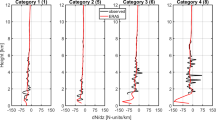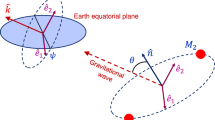Abstract
The Chasing All Transients Constellation Hunters (CATCH) space mission plans to launch three types of micro-satellites (A, B, and C). The type-B CATCH satellites are dedicated to locating transients and detecting their time-dependent energy spectra. A type-B satellite is equipped with lightweight Wolter-I X-ray optics and an array of position-sensitive multi-pixel Silicon Drift Detectors. To optimize the scientific payloads for operating properly in orbit and performing the observations with high sensitivities, this work performs an in-orbit background simulation of a type-B CATCH satellite using the Geant4 toolkit. It shows that the persistent background is dominated by the cosmic X-ray diffuse background and the cosmic-ray protons. The dynamic background is also estimated considering trapped charged particles in the radiation belts and low-energy charged particles near the geomagnetic equator, which is dominated by the incident electrons outside the aperture. The simulated persistent background within the focal spot is used to estimate the observation sensitivity, i.e. 4.22 \(\times \) 10\(^{-13}\) erg cm\(^{-2}\) s\(^{-1}\) with an exposure of 10\(^{4}\) s and a Crab-like source spectrum, which can be utilized further to optimize the shielding design. The simulated in-orbit background also suggests that the magnetic diverter just underneath the optics may be unnecessary in this kind of micro-satellites, because the dynamic background induced by charged particles outside the aperture is around 3 orders of magnitude larger than that inside the aperture.













Similar content being viewed by others
References
Li, P., Yin, Q.-Q., Li, Z., Tao, L., Wen, X., Zhang, S.-N., Qi, L., Zhang, J.,Zhao, D., Li, D., et al.: Catch: chasing all transients constellation hunters space mission. Experimental Astronomy, 1–40 (2023)
Yamaguchi, H., Nakajima, H., Koyama, K., Tsuru, T., Matsumoto, H., Tawa, N., Tsunemi, H., Hayashida, K., Torii, K., Namiki, M., et al.: The background properties of suzaku/xis. In: Space Telescopes and Instrumentation II: Ultraviolet to Gamma Ray, 6266, 1195–1204 (2006). SPIE
Pagani, C., Morris, D., Racusin, J., Grupe, D., Vetere, L., Stroh, M., Falcone, A., Kennea, J., Burrows, D., Nousek, J., et al.: Characterization and evolution of the swift x-ray telescope instrumental background. In: UV, X-Ray, and Gamma-Ray Space Instrumentation for Astronomy XV, 6686, 80–88 (2007). SPIE
Perinati, E., Tenzer, C., Santangelo, A., Dennerl, K., Freyberg, M., Predehl, P.: The radiation environment in l-2 orbit: implications on the non-x-ray background of the erosita pn-ccd cameras. Experimental Astronomy 33, 39–53 (2012)
Tenzer, C., Warth, G., Kendziorra, E., Santangelo, A.: Geant4 simulation studies of the erosita detector background. In: High Energy, Optical, and Infrared Detectors for Astronomy IV, 7742, 293–299 (2010). SPIE
Weidenspointner, G., Pia, M.G., Zoglauer, A.: Application of the geant4 pixe implementation for space missions new models for pixe simulation with geant4. In: 2008 IEEE Nuclear Science Symposium Conference Record, 2877–2884 (2008). IEEE
Fioretti, V., Bulgarelli, A., Malaguti, G., Spiga, D., Tiengo, A.: Monte carlo simulations of soft proton flares: testing the physics with xmmnewton. In: Space Telescopes and Instrumentation 2016: Ultraviolet to Gamma Ray, vol. 9905, pp. 1991–2004 (2016). SPIE
Campana, R., Feroci, M., Del Monte, E., Mineo, T., Lund, N., Fraser, G.W.: Background simulations for the large area detector onboard loft. Experimental Astronomy 36, 451–477 (2013)
Xie, F., Zhang, J., Song, L.-M., Xiong, S.-L., Guan, J.: Simulation of the in-flight background for hxmt/he. Astrophysics and Space Science 360, 1–7 (2015)
Xie, F., Pearce, M.: A study of background conditions for sphinx-the satellite-borne gamma-ray burst polarimeter. Galaxies 6(2), 50 (2018)
Zhang, J., Li, X., Ge, M., Zhao, H., Tuo, Y., Xie, F., Li, G., Zheng, S., Nie, J., Song, L., et al.: Comparison of simulated backgrounds with inorbit observations for he, me, and le onboard insight-hxmt. Astrophysics and Space Science 365(9), 158 (2020)
Zhang, J., Qi, L., Yang, Y., Wang, J., Liu, Y., Cui, W., Zhao, D., Jia, S., Li, T., Chen, T., et al.: Estimate of the background and sensitivity of the follow-up x-ray telescope onboard einstein probe. Astroparticle Physics 137, 102668 (2022)
Agostinelli, S., Allison, J., Amako, K.a., Apostolakis, J., Araujo, H., Arce, P., Asai, M., Axen, D., Banerjee, S., Barrand, G., et al.: Geant4-a simulation toolkit. Nuclear instruments and methods in physics research section A: Accelerators, Spectrometers, Detectors and Associated Equipment 506(3), 250–303 (2003)
Allison, J., Amako, K., Apostolakis, J., Araujo, H., Dubois, P.A., Asai, M., Barrand, G., Capra, R., Chauvie, S., Chytracek, R., et al.: Geant4 developments and applications. IEEE Transactions on nuclear science 53(1), 270–278 (2006)
Allison, J., Amako, K., Apostolakis, J., Arce, P., Asai, M., Aso, T., Bagli, E., Bagulya, A., Banerjee, S., Barrand, G., et al.: Recent developments in geant4. Nuclear instruments and methods in physics research section A: Accelerators, Spectrometers, Detectors and Associated Equipment 835, 186–225 (2016)
Gilli, R., Comastri, A., Hasinger, G.: The synthesis of the cosmic xray background in the chandra and xmm-newton era. Astronomy & Astrophysics 463(1), 79–96 (2007)
Lahav, O., Fabian, A., Barcons, X., Boldt, E., Butcher, J., Carrera, F., Jahoda, K., Miyaji, T., Stewart, G., Warwick, R.: A significant contribution to the cosmic x-ray background from sources associated with nearby galaxies. Nature 364(6439), 693–695 (1993)
Hickox, R., Civano, F., Ballantyne, D., Balokovic, M., Boorman, P., Brandt, W., Canning, R., Fornasini, F., Gandhi, P., Jones, M., et al.: Resolving the cosmic x-ray background with a next-generation highenergy x-ray observatory. arXiv preprint arXiv:1905.11439 (2019)
Gruber, D., Matteson, J., Peterson, L., Jung, G.: The spectrum of diffuse cosmic hard x-rays measured with heao 1. The Astrophysical Journal 520(1), 124 (1999)
Zombeck, M.: Handbook of Space Astronomy and Astrophysics: Third Edition, (2007)
Gehrels, N.: Instrumental background in gamma-ray spectrometers flown in low earth orbit. Nuclear Instruments and Methods in Physics Research Section A: Accelerators, Spectrometers, Detectors and Associated Equipment 313(3), 513–528 (1992)
Ginet, G., O’Brien, T., Huston, S., Johnston, W., Guild, T., Friedel, R., Lindstrom, C., Roth, C., Whelan, P., Quinn, R., et al.: Ae9, ap9 and spm: New models for specifying the trapped energetic particle and space plasma environment. The van allen probes mission, 579–615 (2014)
Petrov, A., Grigoryan, O., Panasyuk, M.: Energy spectrum of proton flux near geomagnetic equator at low altitudes. Advances in Space Research 41(8), 1269–1273 (2008)
Grigoryan, O., Panasyuk, M., Petrov, V., Sheveleva, V., Petrov, A.: Spectral characteristics of electron fluxes at l! 2 under the radiation belts. Advances in Space Research 42(9), 1523–1526 (2008)
Mizuno, T., Kamae, T., Godfrey, G., Handa, T., Thompson, D., Lauben, D., Fukazawa, Y., Ozaki, M.: Cosmic-ray background flux model based on a gamma-ray large area space telescope balloon flight engineering model. The Astrophysical Journal 614(2), 1113 (2004)
Gleeson, L., Axford, W.: Solar modulation of galactic cosmic rays. Astrophysical Journal 154, 1011 (1968)
Qi, L., Li, G., Xu, Y., Zhang, J., Yang, Y., Sheng, L., Basso, S., Campana, R., Chen, Y., De Rosa, A., et al.: Geant4 simulation for the responses to x-rays and charged particles through the extp focusing mirrors. Nuclear Instruments and Methods in Physics Research Section A: Accelerators, Spectrometers, Detectors and Associated Equipment 963, 163702 (2020)
Spiga, D., Raimondi, L., Svetina, C., Zangrando, M.: X-ray beam-shaping via deformable mirrors: Analytical computation of the required mirror profile. Nuclear Instruments and Methodtivitys in Physics Research Section A: Accelerators, Spectrometers, Detectors and Associated Equipment 710, 125–130 (2013)
Zhao, X.-Y., Wang, H.-Y., Wu, F., Meng, X.-C., Ma, Y.-Q., Lu, H., Wang, H., Wang, P., Li, X.-Q., Xu, Y.-B., et al.: A geometric factor calculation method based on the isotropic flux assumption. Chinese Physics C 37(12), 126201 (2013)
Qi, L., Li, G., Xu, Y., Chen, Y., He, H., Wang, Y., Yang, Y., Zhang, J., Lu, F.: A preliminary design of the magnetic diverter on-board the extp observatory. Experimental Astronomy 51, 475–492 (2021)
Vianello, G.: The significance of an excess in a counting experiment: Assessing the impact of systematic uncertainties and the case with a gaussian background. The Astrophysical Journal Supplement Series 236(1), 17 (2018)
Spiga, D., Fioretti, V., Bulgarelli, A., Dell’Orto, E., Foschini, L., Malaguti, G., Pareschi, G., Tagliaferri, G., Tiengo, A.: A magnetic diverter for charged particle background rejection in the simbol-x telescope. In: Space Telescopes and Instrumentation 2008: Ultraviolet to Gamma Ray, 7011, 897–907 (2008). SPIE
Riva, N., Calvelli, V., Musenich, R., Farinon, S., Lotti, S., Saracco, P.: Study of a superconducting magnetic diverter for the athena x-ray space telescope. IEEE Transactions on Applied Superconductivity 28(4), 1–4 (2018)
Wang, L., Qin, L., Cheng, J., Zhang, Z., Wang, Y., Liu, J., Hu, X., Wang, Q., Zhang, C., Zhao, D.: Design of the permanent magnet diverter for deflecting electrons on wide-field x-ray telescope. IEEE Transactions on Applied Superconductivity 30(4), 1–5 (2020)
Acknowledgements
We would like to appreciate the CATCH collaboration. We acknowledge the support from the National Natural Science Foundation of China (NSFC), Grant Nos. 12122306 and 12003037, the Strategic Priority Research Program of the Chinese Academy of Sciences XDA15016400, the CAS Pioneer Hundred Talent Program Y8291130K2. We also acknowledge the Scientific and technological innovation project of IHEP E15456U2.
Funding
We acknowledge funding support from the National Natural Science Foundation of China (NSFC) under grant Nos. 12122306 and 12003037, the Strategic Priority Research Program of the Chinese Academy of Sciences XDA15016400, the CAS Pioneer Hundred Talent Program Y8291130K2, and the Scientific and technological innovation project of IHEP E15456U2.
Author information
Authors and Affiliations
Contributions
Jingyu Xiao and Liqiang Qi wrote the main manuscript. Shuang-Nan Zhang, Lian Tao, and Zhengwei Li assisted with the critical revision of the article. Juan Zhang verified the analytical methods. All authors reviewed the manuscript and contributed to the development of the in-orbit background simulation of CATCH.
Corresponding author
Ethics declarations
Conflicts of interest
The authors declare that they have no conflict of interest.
Additional information
Liqiang Qi and Shuang-Nan Zhang contributed equally to this work.
Rights and permissions
Springer Nature or its licensor (e.g. a society or other partner) holds exclusive rights to this article under a publishing agreement with the author(s) or other rightsholder(s); author self-archiving of the accepted manuscript version of this article is solely governed by the terms of such publishing agreement and applicable law.
About this article
Cite this article
Xiao, J., Qi, L., Zhang, SN. et al. In-orbit background simulation of a type-B CATCH satellite. Exp Astron 56, 477–498 (2023). https://doi.org/10.1007/s10686-023-09902-y
Received:
Accepted:
Published:
Issue Date:
DOI: https://doi.org/10.1007/s10686-023-09902-y




